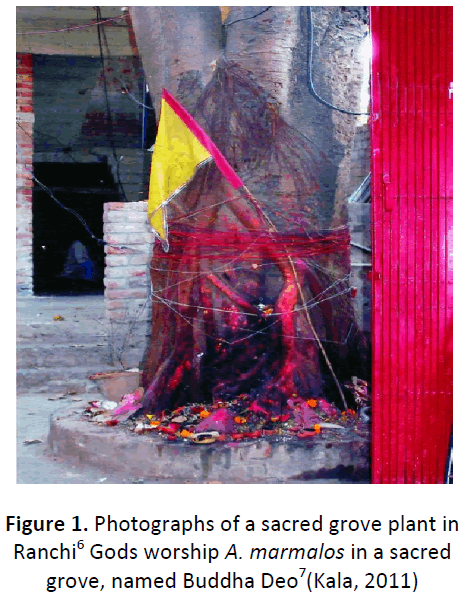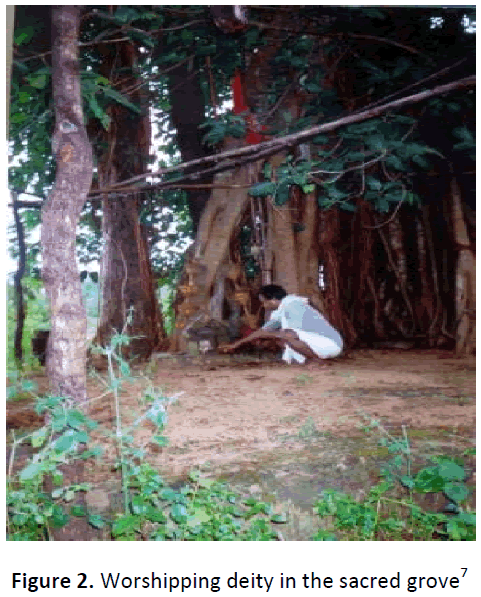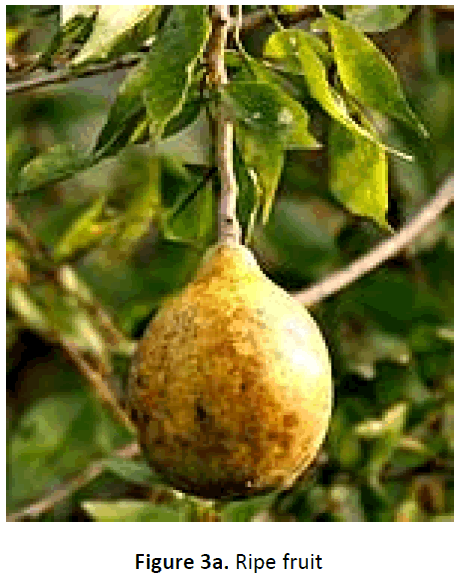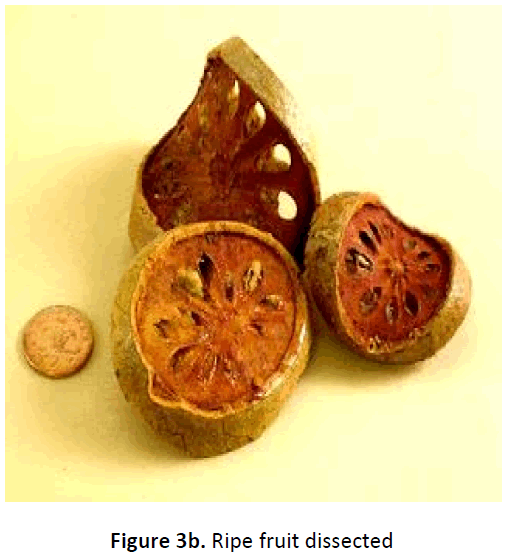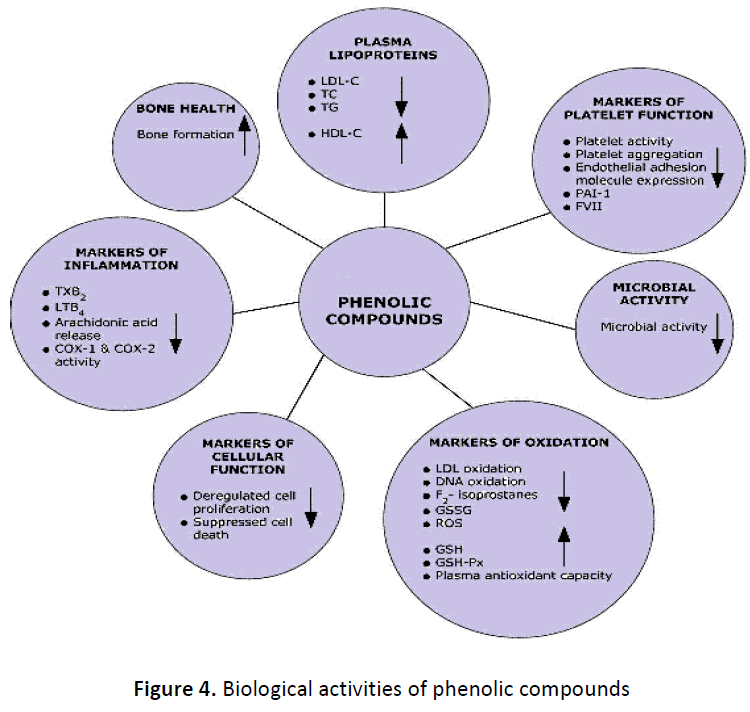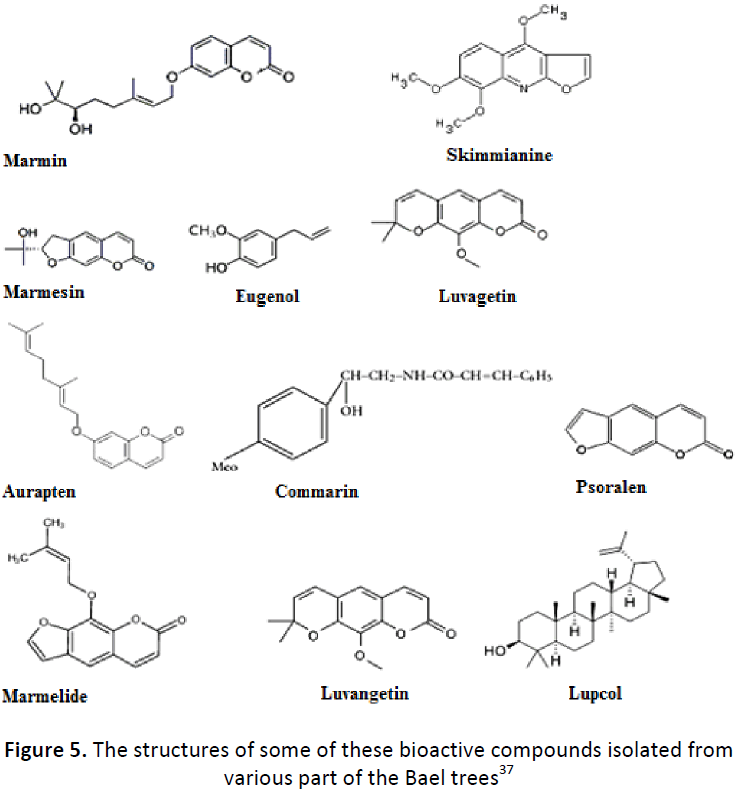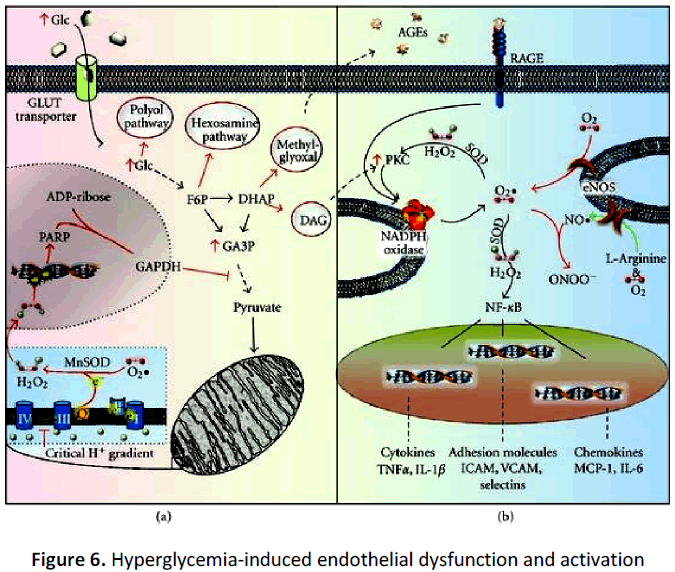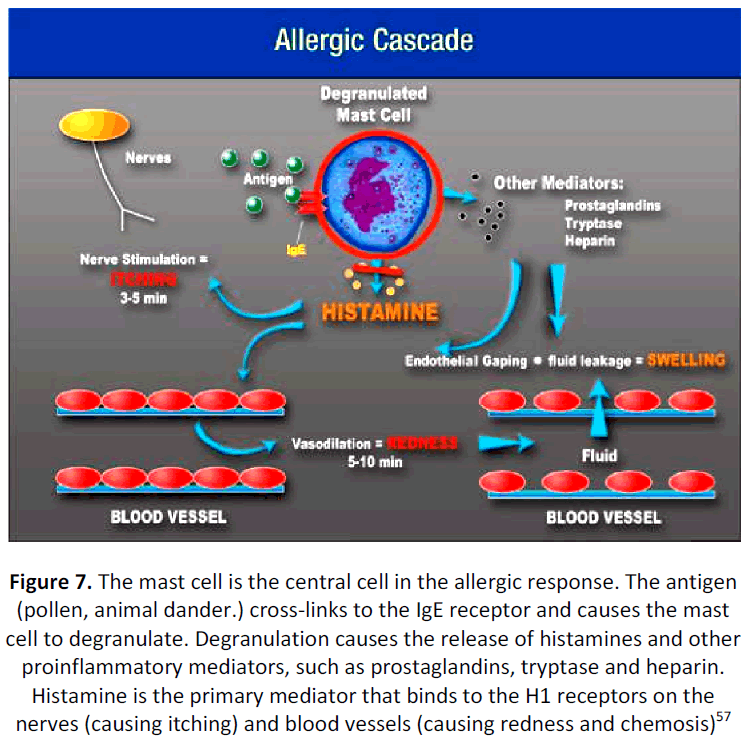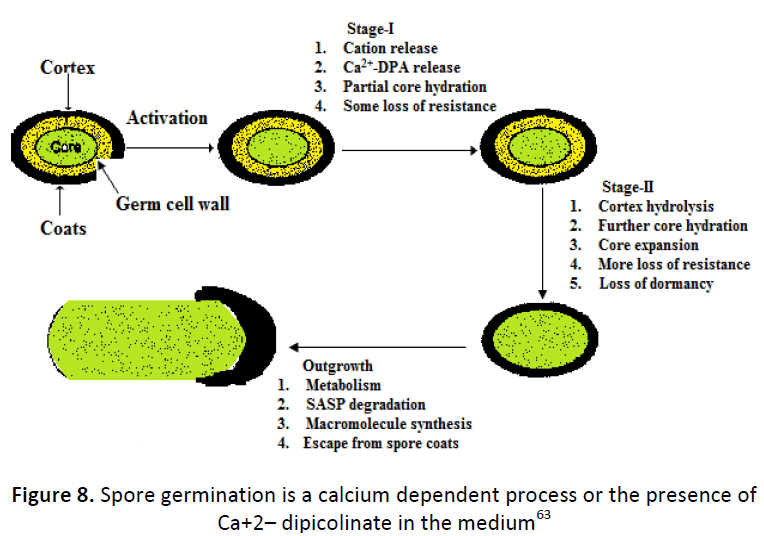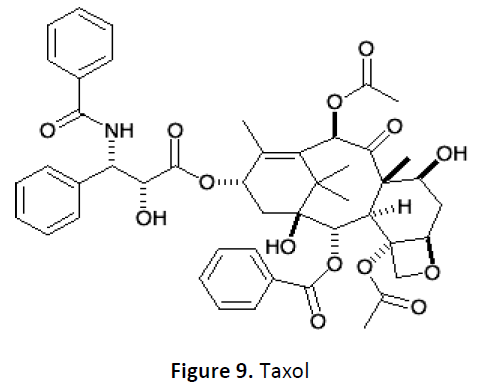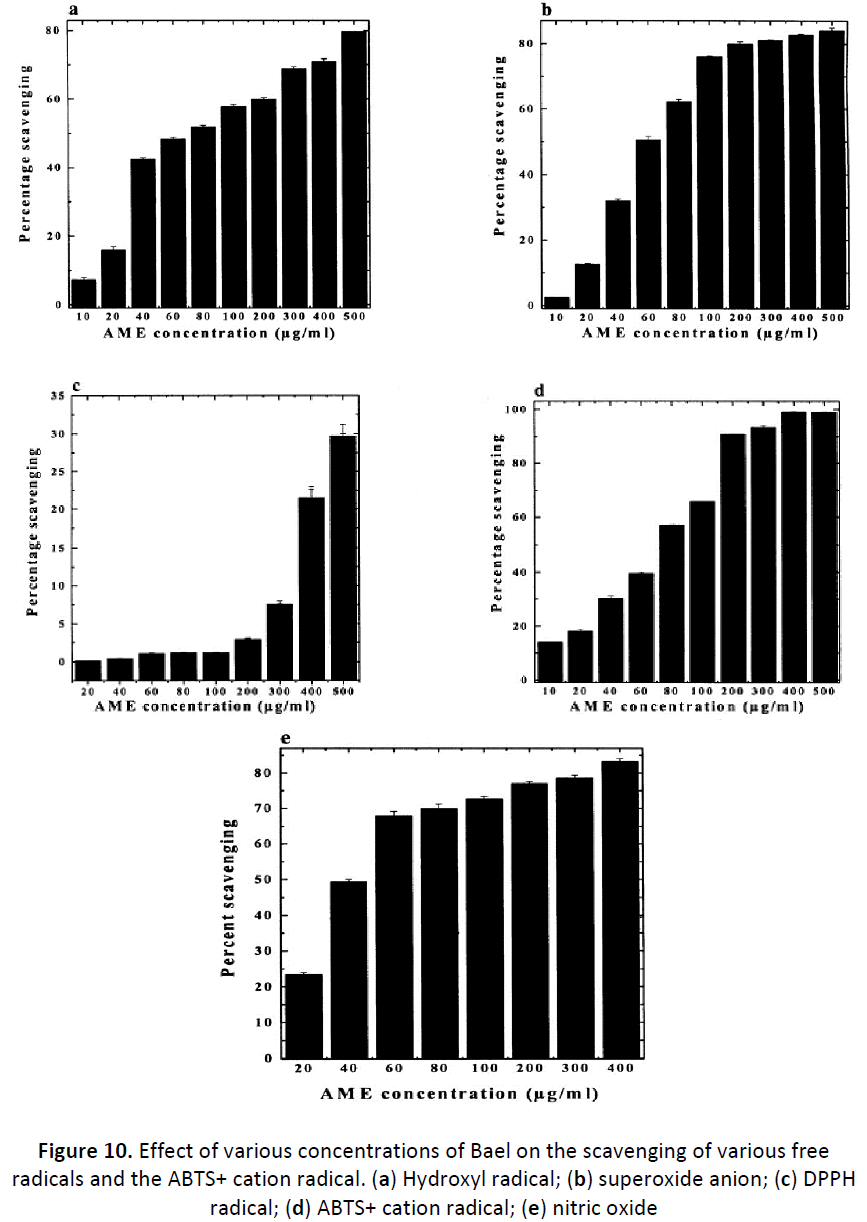ISSN : 2348-9502
American Journal of Ethnomedicine
Ethnological and Ethno-medicinal Importance of Aegle marmelos (L.) Corr (Bael) Among Indigenous People of India
1Department of Zoology, Ranchi University, Ranchi-834008, Jharkhand, India
2R.L.S.Y college Ranchi University, Ranchi-834008, Jharkhand, India
3Department of Botany, Ranchi University, Ranchi-834008, Jharkhand, India
Abstract
The Bael (Aegle marmelos) (L) Corr. Is an important Indian plant, conserved since centuries by tribal communities and in sacred groves, has enormous traditional uses as a food source and against various diseases. Focus on plant research has increased in recent times with an aim towards their edible, medicinal and amelioration properties in animal welfare globally and lots of evidence has collected to show immense potential of nutritional and medicinal plants used in various ethical societies. Over the last few years, researchers have aimed at identifying and validating plant derived substances for the treatment of various diseases and amelioration of toxicity. It has been proved that various parts of plants such as Leaves, fruits, seeds, provide health and nutrition, promoting compounds in the human diet and which has enormous traditional uses against various diseases, especially the ethnic communities of Jharkhand, who suffer from malnutrition and severe health issues. The present paper aims to compile ethnobotanical and ethnomedical values of Aegle marmelos generated through the research activity using modern scientific approaches and innovative scientific tools.
Keywords
Aegle marmelos, Ethnomedical, Ethnobotany, Biochemical, Nutritional, Medical uses.
INTRODUCTION
The indigenous and ethnic people of the world have learnt to live in most hostile environmental condition in this universe [1]. The most interesting feature associated with these indigenous and ethnic has been found that, they live in localities which are immensely rich in biodiversity. India is a country with large ethnic society and has immense wealth due to which it is rich in biodiversity. There are 45,000 species of wild plant out of which 9,500 species are ethno botanically important species. Of these 7,500 species are in medicinal use of indigenous health practices. The ethnic and indigenous people have to depend upon several wild species for fruits, seeds, bulbs, roots and tubers which are used for edible purposes2.
The ethnic community of India has played a vital role in preserving biodiversity of several virgin forests and have conserved several flora and fauna in sacred groves of tribal, otherwise these flora and fauna might have been disappeared from natural ecosystems. A. marmelos is one of such tree which has been conserved since ages [1,3].
Apart from being a medicinal plant, Aegle marmelos Correa is a sacred tree, dedicated to Lord Shiva. The offering of bael leaves is a compulsory ritual of the worship of Lord Shiva in the hills. This importance seems largely due to its medicinal properties. All parts of this tree, viz., root, leaf, trunk, fruit and seed, are used for curing one human ailment or another [4].
More than 70% of the tribal communities remained intermingled with the nature and traditional knowledge for thousands of years and are the custodian of numerous indigenous plants that are used for the cure of several ailments [5]. One of the principal reasons for such a practice is the lack of modern medical facilities in the remote areas of the difficult terrains of the state.
There is a widespread belief that the green medicines are healthier and more harmless or safer than synthetic ones [8]. The present study, therefore, aims to document various indigenous uses of Aegle marmelos (L.) Correa, one of the most important medicinal plants of India, for its immense low cost medical importance and to emphasize its ethno conservation for the benefit of mankind. The fruit’s medicinal value is very high when it is just beginning to ripen; therefore it is best eaten just as fresh as it ripens. The ripe fruit and unripe fruit, as well as the roots, leaves and branches have all been used in traditional medicine. In Ayurveda, the ripe fruit has been used for chronic diarrhea and dysentery, as a tonic for the heart and brain, and as adjuvant treatment of dysentery. A decoction of the root has been used to treat melancholy, intermittent fevers and palpitation; the roots have mainly been used as an ingredient of the Ayurvedic medicine, dashmool. The leaves have been given as febrifuge and as a poultice for the treatment of eye disorders and ulcer and administration of fresh leaves have been used for weakness of the heart, dropsy and beriberi.
The word bilva (bel tree) is usually used as bilva-patra (leaf of bel). It is a sacred tree having sacrificial importance. The leaves of this sacred tree are generally trifoliate. This trifoliate leaf is symbolic of Trikal (Brahma, Vishnu and Mahesh), three eyes of Lord Shiva, Trishakti (Volition, action and knowledge), three lingas and three syllables of Omkar.
The bilva tree itself is so holy and auspicious that its worship or its significance is mentioned in many Puranas and other scriptures at various instances. Born from the breasts of Goddess Lakshmi, the Bilva tree is ever dear to Mahadeva. So I ask this tree to offer a Bilva leaf to Lord Shiva. To have Darshan of the Bilva tree, and to touch it, frees one from sin. The most terrible karma is destroyed when a Bilva leaf is offered to Lord Shiva. Sri Bilva Shtakam [9]. The proportion of Sattva component is more in bilva patra and hence it has more capacity to absorb and emit Sattvik frequencies. This has various effects. One of them is the reduction of raja-tama particles present in the atmosphere. A Sattvik leaf like bilva patra when brought in proximity of a person suffering from negative energy, distress than the black energy present within him is reduced [10].
In a study in the Bundu block indicated that A. marmelos can be a good cash crop, indicating that the inhabitants earn Rs.2991/annum selling ripe fruits and approximately 30 households are involved in this business [11].
Ethnic value of A. marmelos
In India there are 68 million people, belonging to 227ethnic groups (573 tribal communities) [12], live close in the vicinity of the forests or villages and have been able to conserve biodiversity of their localities. The forest and trees/plants not only cater their daily needs of timber and fuel wood, but also their livelihood and traditional medicines.
There are 45,000 species of wild plants out of which 9500 species are ethnobotanically important and 7500 species are used as medicinal and herbal health practices. Many of these plants are conserved and worshipped in their natural habitat due to their magical- religious belief that they are habitat of God and Goddess [3]. Bael is one of them, worshipped as a symbol of Lord Shiva.
Many of these plants are conserved in sacred groves. It has been estimated that the total number of sacred groves in the country lies between 100,000 and 150,000 [14]. These are mainly distributed in the states of Andhra Pradesh, Bihar, Jharkhand, Orissa, Maharashtra [15] Sacred Groves is an age-old tradition where a patch of forest or water body is dedicated to local deities and none is allowed to cut plants or to kill animals or any form of life (Figure 1 & 2). The institution of sacred groves dates back to the pre-agrarian hunting-gathering phase of human civilization and is known to thrive in most parts of India. A. marmelos are an important plant of such sacred grove of Jharkhand [6].
Besides conservation of biodiversity, the role of sacred groves is also important as a life support system. The sacred groves help tribal communities by providing edible fruits, leaves, fibers and medicinal plants. Also acts as an atmosphere purifier and sinks, air pollutants and deodorizes bad air [10]. An example of sacred groove is shown in a sacred grove in Panchmarhi village, where Gonds worship A. marmelos apart from other sacred trees (Table.1).
Table 1: Sacred grove in panchmarhi village [7]
| Communities | Name of the groove | Deities worshipped | Plants symbolized as abode of deities | Age of the groove (approx) | Groove size (approx) |
|---|---|---|---|---|---|
| Gond | Khedapati | Khedapati | Shorea robusta, Madhuca indica, Dendrocalamus strictus Terminalia bellirica, Ficus bengalensis, Mucuna pruriens, Phyllanthus sylvestris, Phyllanthus officinalis, Buchnania lanzan | 200-250 | 0.20 hectares |
| Gond | Budh Deo | Budha Deo | Aegel marmelos, Shorea robusta, Dendrocalamus strictus Ficus religiosa, Butea monosperma, Madhuca indica, Ficus bengalensis | Not known | 0.10 hectares |
Occurrence, botanical description
A. marmelos is one of the most important medicinal plants of India, Burma and Ceylon [16]. It is found as a wild plant found all over India and cultivated in north India. The Aegle is a small genus of three species distributed in tropical Asia and Africa. The A. marmelos belongs to the family Rutaceae and is known as Opesheet, Ohshit. It is termed differently in different languages as well as countries [17].
A. marmelos are a subtropical species and grow best in rich, well-drained soil. It grows well in swamps, alkaline or stony soils having a pH range from 5 to 8 [17]. In India flowering occurs in April and May and the fruit ripens in 10 to 11 months after (March to June) of the following year [17]. A. marmelos are a slow- growing, medium sized tree, up to 12 to 15 m tall with short trunk, thick, soft, flaking bark and spreading, sometimes spiny branches. A clear, gummy sap, resembling gum Arabic, exudes from wounds branches.
The marmelos tree
The deciduous, alternate leaves, borne singly or in 2's or 3's, are composed of 3 to 5 oval, pointed, shallowly toothed leaflets, 4 to 10 cm long, 2 to 5 cm wide, the terminal one with a long petiole. New foliage is pinkish-maroon and glossy. Damaged leaves emit a foul odor.
Flowers are fragrant, found in clusters of 4 to 7 along the young branch lets, have 4 fleshy petals, green outside, yellowish inside, and 50 or more greenishyellow stamens. Fruit is round, pyriform, oval or oblong, 5 to 20cm in diameter, may have a thin, hard, woody shell, gray-green when immature but turns yellowish when fully ripe. Inside, there is a hard central core and 8 to 20 faintly defined triangular segments, with thin, dark- orange walls, filled with aromatic, pale orange, pasty, sweet, resinous, astringent pulp 10 to 15 flattened-oblong seeds remain embedded in the pulp. The seeds are about 1 cm long, covered with woolly hairs and each enclosed in a sac of adhesive, transparent mucilage that solidifies on drying (Figure 3a & 3b).
The Ethnomedicinal importance of A. marmelos
This plant is used in traditional medicine treatments, such as intermittent fever, intestinal ailments, fertility control and treatment after childbirth and fish poison [18]. British pharmacopoeia has included A. marmelos fruit because of its effectiveness against diarrhoea and dysentery [19]. Moreover, Chopra (1982) has appropriately stated that “No drug has been longer and better known, nor more appreciated by the inhabitants of India than the Bael fruit”.
Leaves
Extracts of leaves are efficient to treat ulcers, abscess, backache, vomiting, cuts, weakness of heart, acute bronchitis, blood sugars, diarrhea, dropsy, beriberi, injuries caused by animals [20]. Juice prepared from the leaf extract acts as a laxative agent and is helpful for treating ophthalmic infections and asthmatic complaints. Medicated oil prepared from the leaves of the plant not only helps to prevent cold, cough and other respiratory ailments, but is also a good hair tonic when mixed with cumin seeds and massaged on the scalp.
Leaves are also used as a veterinary medicine for wound and fodder for animals and stimulation of denervated nictitating membrane in anesthetized cats [21]. A brief outline of A. marmelos indicating the Ethnomedicinal importance of various parts of the plant is shown in Table 2.
Table 2: The ethnomedicinal importance of A. marmelos [28]
| Leaves | Extracts of leaves are efficient to treat ulcers, abscess, backache, vomiting, cuts, weakness of heart, acute bronchitis, blood sugars, diarrhoea, dropsy, beri-beri, injuries caused by animals, etc20. Juice prepared from leaf extract acts as laxative agent and is helpful for treating ophthalmic infections and asthamic complaints. Medicated oil prepared from leaves of the plant not only helps to prevent cold, cough and other respiratory ailments but is also a good hair tonic when mixed with cumin seeds and massaged on the scalp. Leaves are also used as a veterinary medicine for wound and fodder for animals and stimulation of denervosed nictitaing membrane in anaesthetized cats21. |
| Root bark | Root bark is used in remission of intermittent fevers fever, fish poison, remedy for heart palpitation and melancholia. Bark juice, mixed with cumin in milk, increases seminal fluid volume. Alcoholic root extracts cure hypoglycemia22. It is also used in dog bite, gastric troubles, heart disorders, antiamoebic, rheumatism23. |
| Flower | Extracts of distilled flower is used as tonic for stomach, intestine, anti-dysenteric, anti- diabetic, diaphoretic and local anesthetic24. As expectorant it is used to cure epilepsy. |
| Fruit | Eaten during diarrhea, dysentery and convalescence. It act as a mild astringency. Dry powder mixed with mustard oil is used to treat burn cases25. Fruits are used in diarrhea, dysentery, gastric troubles, constipation, laxative, tonic, digestive, brain and heart tonic, ulcer, intestinal parasites, gonorrhea, epilepsy23. Fresh fruit extracts lower blood pressure26. Fine powder of unripe fruit can be an alternative medicine to cure intestinal parasites, like Entamoeba histolitica, Ascaris lumbricoides27. |
| Seed | Seed oil exhibit antibacterial effect against Vibrio cholera, Staphylococcus aureus and Escherichia coli29. Essential oil also exhibit antifungal activity against Physallospora tucumanesis, Eratocystis paradoxa, Selerotium raffsii, Curvularia lunata, helminthosporium sacchari30. |
Root bark
The root bark is used in remission of intermittent fevers, fish poison, remedy for heart palpitation and melancholia. Bark juice, mixed with cumin in milk, increases seminal fluid volume. Alcoholic root extracts cure hypoglycemia [22]. It is also used in dog bite, gastric troubles, heart disorders, anti-amoebic, rheumatism [23].
Flower
Extracts of distilled flower are used as a tonic for the stomach, intestine, antidysenteric, anti-diabetic, diaphoretic and local anesthetic [24]. As an expectorant it is used to cure epilepsy.
Fruit
Eaten during diarrhea, dysentery and convalescence. It acts as a mild astringency. Dry powder mixed with mustard oil is used to treat burn cases [25].
Fruits are used in diarrhea, dysentery, gastric troubles, constipation, laxative, tonic, digestive, brain and heart tonic, ulcer, intestinal parasites, gonorrhea, epilepsy [22]. Fresh fruit extracts lower blood pressure [26]. Fine powder of unripe fruit can be an alternative medicine to cure intestinal parasites, like Entamoeba histolytica, Ascaris lumbricoides [27].
Phytochemical constituents isolated from A. marmelos
Various chemical constituents like alkaloids, coumarins and steroids have been isolated and identified from different parts of the tree. The biological activities of the phenolic compounds present in A. marmelos is shown in Figure.4, indicating the widespread therapeutic effect of the plant.
Coumarins
Farooq, (2005) reported presence of marmelosin, marmesin, imperatorin, marmin, alloimperatorin, methyl ether, xanthotoxol, scopoletin, scoparone, umbelliferone, psoralen and marmelid. Marmenol, a 7-geranyloxycoumarin [7-(2, 6-dihydroxy-7- methoxy-7-methyl-3-0ctaenyloxy) Coumarins] [31].
AlkaloidsManandhar et al. (1978) identified the presence of aeglin, aegelenine, dictamine, fragrine (C13H11O3N) [32], Omethylhalfordinine, isopentenylhalfordinol33, N-2-[4-(3’, 3’-dimethylallyloxy) phenyl] ethyl cinnamide, N-2-hydroxy-2-[4- (3’, 3’- dimethylallyloxy) phenyl] ethyl cinnamide, N-2-hydroxy-(4-hydroxyphenyl) ethyl cinnamide [34], O-(3, 3-dimethylallyl) halofordinol, N-2-ethoxy-2-(4-methoxy phenyl) ethyl cinnamide, N-2-methoxy-2-[4- (3’, 3’dimethylallyloxy) phenyl] ethylcinnamide, N-2-methoxy-2-(4-methoxyphenyl)- ethylcinnamide.
Polysaccharides
Galactose, arabinose, uronic acid and L-rhamanose are obtained on hydrolysis [35]. Seed oil composed of palmitic, stearic, oleic, linoleic and linolenic acid [33].
Tannins
Tannin content is maximum in the bael fruit in the month of January. There is as much as 9% tannin in the pulp of wild fruits, less in cultivated type. Tannin is also present in leaves as skimmianine, it is also named as 4, 7, 8-trimethoxyfuro, quinoline.
The pale color of the fruit is because of the presence of carotenoids. The therapeutically Carotenoids active principles of bael plant are due to the presence of marmelosin, skimmianine and umbelliferone are. The small amount of ascorbic acid, sitosterol, crude fibers, tannins, α-amyrin, carotenoids and crude proteins are also present. The Roots contain psoralen, xanthotoxin scopoletin33 and also compounds like praealtin D, trans-cinnamic acid, 4-methoxy benzoic acid, betulunic acid and montanin36. Bael tree also possess a large number of bioactive compounds in its various parts as shown in Table 3. The structures of some of these bioactive compounds are presented in Figure 4.
Table 3: Some of the important photochemical compounds isolated from different plant parts of A. Marmelos10
| S. No. | Part | Phytoconstituents |
|---|---|---|
| 1 | Leaf | Skimmianine,Aegeline,Lupeol,Cineol,Cuminaldeyde, Eugenol, Marmesinine, Citronella |
| 2 | Bark | Skimmianine, Fagarine, Marmine, |
| 3 | Fruit | Marmelosin, Luvangetin, Aurapten, Psoralen, Marmelide, Tannin |
Bioactivity
Leaves, fruits, stem and roots of A. marmelos have been used in ethno medicine due to its astringent, anti-diarrheal, antidysenteric, demulcent, antipyretic and antiinflammatory activities [37]. Bioactive compounds of bael fruit contain relatively high content of dietary fiber, ascorbic acid, total phenolics, total flavonoids, total carotenoids and also strong antioxidants. The main components were monoterpenes and sesquiterpenes. Among these components, limonene was the major constituent producing the characteristic bael fruit flavor [38]. The flow chart of the Biological Activities of Phenolic Compounds is shown in Figure. 5.
Figure 5: The structures of some of these bioactive compounds isolated from various part of the Bael trees [37]
Antiulcer activity
Ulcer develops when there is an imbalance between the defensive mechanism on the mucosa resulting from either due to the presence aggravating factors and/or lowering of mucosal protection [39]. Contemporary therapeutic treatment uses proton pump inhibitors and selective H2 receptor blockers, but with several side effects and execute their actions within a limit. Bael has a prominent gastroprotective effect due to the presence of Luvangetin, a pyranocoumarin Cineole and the tannin in the fruit. Oxidative stress usually leads to gastric ulcer. Luvangetin lowers oxidative stress in the gastro duodenal mucosa preventing ulcer formation. The phenolic compounds are potent antioxidants [40] and have powerful antiulcer activities [41].
Antioxidant activity
Treatment with Bael leaf extracted showed dose–related increase in their level/activity of antioxidative parameters like reduced glutathione, glutathione peroxidase, glutathione reductase, super oxide dismutase (SOD) and catalase and a decrease in lipid peroxidation [42]. A dose of 250 mg/kg body weight of the fruit extract is more effective than glitenclamide (300 μg/kg)43. Leaf extract (200 mg/kg) is as effective as alpha tocopherol (60mg/kg) in isoproterenal (ISO) -treated rats [44]. The antioxidant phytochemical such as flavonoids, alkaloids, sterols, tannins, phlobatannins and flavonoid glycosides present in the leaf extract possess this free radical scavenging activity [45]. Diabetes causes reduction in the level of Glutathione (GSH) is in erythrocyte and increase of plasma glutathione-S-transferase (GST) and malondialdehyde (MDA) in male albino rats.
However, the antioxidant potential of Bael leaves brings back the level to normal [46]. Figure.6 indicates the pathway of hyperglycemia-induced endothelial dysfunction and activation. (a) Hyperglycemia induces metabolic dysfunction through the mitochondrial production of superoxide, resulting in PARP activation and subsequent altered glycolytic flux to enhance diacylglycerol production (DAG), methylglyoxal production, and hexosamine and polyol pathway activity. (b) Hyperglycemia-induced oxidative stress is further enhanced by metabolic overproduction of DAG and decreases in NADH+/reduced glutathione (GSH), as well as stimulation of the RAGE receptor. Oxidative stress reduces protective mediators (NO bioavailability) and enhances inflammatory transcription factor (NF-κB) activation resulting in inflammatory gene expression and leukocyte recruitment [47]. Eugenol and Marmesinin are potent antioxidants may be responsible for preventing oxidative stress [48].
Antimalarial activity
Malaria caused by Plasmodium falciparum causes about 2 million deaths annually [49]. Moreover, the species are gradually getting resistant to existing antimalarial drugs, complicating the treatment of this dreadful disease [50]. The alcoholic extracts of the Bael seeds and leaves have been tested in vivo and in vitro for antimalarial activity against the NK65 strain of Plasmodium berghei. The seeds have shown schizontocidal activity in both the system, whereas, the leaves have shown activity only in the in-vitro system [51].
Antidiabetic activity
The extracts of the plant have a multidirectional antidiabetic action that can significantly lower the levels of blood glucose and glycosylated hemoglobin and increased the plasma insulin as well as liver glycogen in diabetic rats [52]. It has been noted that oxidative stress of the body is closely related diabetes and its related complications [53], as well as with cardiovascular as well as renal disorders. Administrations of the aqueous extract of Bael fruit, orally or intraperitoneal induce a hypoglycemic effect against streptozotocin induced diabetic rats [54].
A dose of 250 mg/kg of the fruit extract proved to be more effective than the hypoglycemic drug, glibenclamide [55]. Coumarins in the fruit extract have the most potent antidiabetic effect, which promotes potentiate the insulin Secretion from the islets of Langerhans [54]. A 15 days clinical trial of a leaf extract for significantly reduced blood cholesterol levels with slight lowering of blood glucose in some patients with diabetes mellitus [56].
Anti-inflammatory activity
Anti-inflammatory, analgesic and antipyretic activities of the organic extracts of the ball leaves have now been established [58], may be due to the presence of Lupeol and Skimmianine in the leaves [57]. Activation of histamine receptor is essential for allergic and asthmatic manifestation [59]. The alcoholic extract of Bael leaves, containing Lupeol and Citral antagonized the histamine–induced contractions and demonstrated positive chain, suggesting inhibition of H1-receptor activity [60] and act through inhibition of histamine mediated signalling [57] and relaxant effect in isolated guinea pig ileum and tracheal.
Histamine receptor antagonism
When histamine binds to a receptor on nerve or vascular cells, it produces the signs and symptoms of allergy. Antihistamines are inert molecules, stereochemically identical to histamines. However, antihistamines have a much greater affinity to receptors than histamine does, so they displace the histamine and shut down the allergic response. In fact, at marketed concentrations, antihistamines have a much greater affinity for H1 receptors than histamine does. That explains the ability of antihistamines to stop the allergic response (Figure.7).
Figure 7: The mast cell is the central cell in the allergic response. The antigen (pollen, animal dander.) cross-links to the IgE receptor and causes the mast cell to degranulate. Degranulation causes the release of histamines and other proinflammatory mediators, such as prostaglandins, tryptase and heparin. Histamine is the primary mediator that binds to the H1 receptors on the nerves (causing itching) and blood vessels (causing redness and chemosis) [57]
Antifungal activity
Essential oil extracted from the leaves of the Bael tree shows potent antifungal activity against animal and human fungi like: Trichophyton mentagrophytes, T. rubrum, Microsporum gypseum, M. audouinii, M. cookie, Epidermophyton floccosum, Aspergillus niger, A. flavus and Histoplasma capsulatum [61].
The oil of the seed has exhibited considerable in-vitro activity against various fungi namely: Trichophyton rubrum, T. terrestre, E. floccosum, Aspergillus fumigatus, A. niger and A. flavus. The ethanolic extract of the root has shown activity against A. fumigates and T. mentagrophytes [62].
The germination of any spore (that is bacterial or fungal) is linked to Ca+2– dipicolinate and/or free Ca+2 ion availability in the medium as well as within the cytoplasm of microbes [63]. It is possible that the essential oil from the Bael leaves may interfere with the Ca+2–dipicolonic acid metabolism pathway and thereby inhibit spore germination (Figure. 8).
Antibacterial activity
Various extracts of A. marmelos have been found to be active against several bacterial strains. For example essential oil of the leaf inhibits the growth of Escherichia coli64, Aeromonas sp., Pseudomonas salanacearum and Xanthomonas vesicatoria [65]. The ethanolic extract of the root and seed inhibits the propagation of Vibrio cholerae, Salmonella typhimurium, Klebsiella pneumoniae, E. coli, Pseudomonas aeruginosa, Bacillus subtilisand Staphylococcus aureus [62], S. typhi, S. aureus, Pseudomonas putida and Bacillus anthracis [66]. Methanol and aqueous extract of Bael fruit have shown strong activity against multidrug resistant S. typhimurium. Methanolic extract is more potent than the aqueous extract. The minimum inhibitory concentration (MIC) value of the methanolic extract is around 256 μg/ml.
It is, thus, evident that Baal has antimicrobial activities may be by blocking protein synthesis either at transcription or translation level and/or peptide-glycan synthesis at membrane level. The antibacterial activity of leaf extract may be due to the presence of Cuminaldehyde and Eugenol [67].
Antiviral activity
The IC50 of leaves, stem and stem bark, fruit, root and root bark and purified compound Marmelide are 1000, 500 to 1000, 250 to 500 and 62.5 μg/ml, respectively, whereas, the IC50 of Ribavirin, a standard antiviral agent, is 2000 μg/ml for the same viruses and at the same time period [68]. Thus, marmelide is the most effective virucidal agent interfering with early events of its replicative cycle [68]. It appears that Bael extracts act upon the early stages of viral replication with minimum host cytotoxicity in contrast to ribavirin (a modern virucidal chemotherapeutic agent), that act in the later stages of viral replication with a lot of side effects [69]. Ranikhet disease virus can be controlled by 50% ethanolic extract of the fruits [70]. Fruits also contain interferon–like activity against the same virus [71]. Thus A. marmelos has a better virucidal potential and may be exploited as a potent antiviral agent in the near future.
Anticancer activity
Anticancer effect on the animal model of Ehrlich ascites carcinoma of hydro- alcoholic extract (400 mg/kg) of Bael leaves shows the greatest antitumor effect [72]. It inhibited in-vitro proliferation of human tumour cell lines including the lecukenic K562, T-lymphoid jurhat, Beta lymphoid Raji, Erythro leukemic HEL [73].
The plant extract exhibits cytotoxicity against tumor cell lines in brine shrimp lethality assay and methyl thiazolyl tetrazolium (MTT) based assay [74]. The extract also possesses anti-proliferative activity on MCF7 and MDA-MB-231 breast cancer cell lines [75]. Skimmianine in the leaf extract induces apoptosis thereby killing the tumor cells [72]. Taxol is an important anticancer drug widely used in the clinic (Figure.9). Bael also possesses an endophyte fungus Bartalinia robillardoides (strain AMB-9), which secretes 187.6 μg/l of Taxol, suggesting that the fungus can serve as a potential material for genetic engineering to improve the production of taxol [76].
Radioprotective activity
Cultured human peripheral blood lymphocytes (HPBLs) were irradiated with different doses of gamma-radiation, which caused a dose-dependent increase in the frequency of lymphocytes bearing one, two and multiple micronuclei, which significantly reduced when treated with 5 μg/ml leaf extract. This radio protective effect was due to the scavenging of radiation–induced free radicals [77]. Identical experiment was conducted in Swiss albino male mice. The mice were administered with various intraperitoneal single doses of the extract. The optimum radio protective dose of the extract has been found to be five consecutive doses of 15 mg/kg body weight [72].
Irradiation caused an elevation in the lipid peroxidation leading to dose dependent decline in the level of glutathione. Bael leaf extract arrested glutathione decline and lipid per oxidation significantly [31]. Symptoms of sickness and mortality of the animals are due to irradiation resulting in a dosedependent elevation in lipid per oxidation in liver, kidney, stomach and intestine as well as depletion in GSH concentration. Treatment of the Bael fruit extract before irradiation caused a significant decrease in the lipid peroxidation accompanied by a significant elevation in the GSH concentration in liver, kidney, stomach and intestine of mice [72] (Figure.10).
Antihyperlipidaemic activity
Pre-treatment with the Bael leaf extract at 100 mg/kg and 200 mg/kg doses for 35 days have shown significant improvement in the activities of marker enzymes, decrement of lipid peroxides, plasma lipids and lipoproteins in isoproterenol-treated rats, suggesting its antihyperlipidaemic effect45. The higher level of fatty acid and their metabolites such as acyl carnitine and long chain acyl CoA usually interfere with NA + /K+ ATPase activity level [54].
Oral administration of the aqueous extract of Bael fruits and seeds separately to streptozotocin-induced diabetic rats significantly lowered the serum and tissue lipid profile [78]. Ethanolic extract of Bael leaves also inhibited the elevation of serum cholesterol and triglyceride level in triton treated hyperlipidemia rat [79]. This extract also potentiates glucose utilization.
Other activities
Leaf extract (1 gm/kg) of A. marmelos was investigated in the regulation of thyroid hormone in male mice. While serum level of both T (3) and T (4) were inhibited by extract of A. marmelos could decrease only T (3) concentration about 62% indicating its possible use in the regulation of hyperthyroidism [80].
Effects of methanolic extract of the root bark of Bael, an Ayurvedic crude drug used for heart disease and constituents isolated from the extract on the spontaneous beating of cultured mouse myocardial cells were examined. The extract at a concentration of 100 μg/ml inhibited the beating rate by approximately 50%. Among the isolated constituents, Aurapten was the most potent inhibitor; the IC50 of Aurapten is 0.6 μg/ml, which is comparable with that of Verapamil, a calcium antagonist. Addition of Aurapten at concentrations higher than 1 μg/ml significantly reduced the ratio of morphologically changed myocardial cells, which originated from calcium overload caused by successive treatment with calcium–free and calcium–containing solutions [81].
Bioassay-directed fractionation of the ethyl acetate extract of the stem bark of A. marmelos afforded a new compound, named Skimmiarepin C, along with Skimmiarepin A. These compounds exhibit moderate insecticidal activity against Phaedon cholera and Musca domestica in comparison with natural pyrethrum extract [82].
The Bael plant acts as a ‘Sink’ for chemical pollutants as it absorbs poisonous gases from the atmosphere and make them inert or neutral. It is a member of the plant species group known as ‘Climate Purifiers’, which emit greater percentage of oxygen in sunlight as compared to other plants. The tree is also considered under the category of ‘Fragrant’ species, whose flowers and volatile vapors neutralize the bad smell of petrified organic matter or decaying refuge and thus save human life from bacterial attack by making them inert and deodorizing the bad odor of air [83].
Toxicological studies
A. marmelos have been used for centuries in India not only for its dietary purposes, but also for its various medicinal properties [84]. Hence, it is generally considered safe and few studies have been carried out with respect to its toxicity. Nevertheless aqueous extract of A. marmelos fruit has been reported to be non mutagenic to S. typhimurium strain TA 100 in the Ames assay [85]. In addition, acute toxicity studies have reported that a hydroalcoholic extract of A. marmelos fruit is non toxic up to a dose of 6 g/kg body weight in mice [86]. Pharmacological studies on animal models involving repeated doses of A. marmelos fruit extract over a period of up to 30 days have not reported any adverse effect up to a maximum dose of 250 mg/kg body weight [87]. There were no remarkable changes noticed in histopathological studies after 50 mg/kg body weight of the extracts of A. marmelos when administered intraperitoneally for 14 days successively. Pathologically, neither gross abnormalities nor histopathological changes were observed. After calculation of LD (50) values using graphical methods, we found a broad therapeutic window and a high therapeutic index value for A. marmelos extracts. Intraperitoneal administration of the extract of the leaves of A. marmelos at doses of 50 to 90 and 100 mg/kg body weight for 14 consecutive days to male and female Wistar rats did not index any shortterm toxicity. Collectively, these data demonstrate that the extracts of the leaves of A. marmelos have a high margin of drug safety88.
CONCLUSION
Aegle marmelos may impart health benefits when it is used in functional food products and should also be regarded as a potential nutraceutical resource in the future. In addition, it can be used as a food additive because of its typical color, flavor and texture. These results are useful for developing and improving the quality of bael fruit cultivate in order to provide more value added and usefulness of bael fruit.
It is quite evident from this review that Aegle marmelos contains a number of phytoconstituents which reveals its uses for various therapeutic purposes. The extracts of this important medicinal plant can be the main form of health care for not only the poor tribal community of Jharkhand but can also form an integrated component of mainstream health care or an alternative or complement to the main form of health care. In an era when traditional know how is getting recognized, these indigenous drugs can serve as healthy, cheap and readily available substitutes of relatively more sophisticated, expensive and ill effect causing active principle based synthetic medicines. The indigenous art of healing is waiting to be transformed into an exact science.
REFERENCES
- Rajiv Rai https://www.fao.org/docrep/article/ wfc/xii/0186-a1.htm, Vijendra Nath (2000). The Role of Ethnic and Indigenous People of India and Their Culture in the Conservation of Biodiversity. https://www. fao.org/docrep/article/wfc/xii/0186-a1.htm.
- https://www.fao.org/docrep/article/
- Rawat RBS, Uniyal RC (2003). National medicinal plant board committed for overall development of the sector. Agro. Bios. Med. Plant, 1: 12-16.
- Parmar, C. and M.K. Kaushal. 1982. Aegle marmelos. p. 1–5. In: Wild Fruits. Kalyani Publishers, New Delhi, India.
- Tomar JB, Bishnoi SK, Saini KK (2012). Healing the tribal way: Ethno-medicinal formulations used by the tribes of Jharkhand, India. Int. J. Med. Arom. Plants. 2 (1):97-105.
- Smita K, Pandey R (2010). Studies on sacred groves of Ranchi district: traditional Way of conserving plants. The Socioscan; 2 (3&4): 19-22.
- Chandra Prakash Kala Traditional Ecological Knowledge, Sacred Groves and Conservation of Biodiversity in the Pachmarhi Biosphere Reserve of India. Scientific Research An Academic Publisher. Vol.2 No.7, 2011.
- Parvath S, Brindha R (2003). Ethnobotanical medicines of Animalai union. Ancient Sci. Life, 22: 14.
- https://in.answers.yahoo.com/question/index ?qid=20110718022121AAlKm1B
- Sharma GN, Dubey SK, Sharma P, Sati N (2007). Medicinal Values of Bael (Aegle marmelos) (L.) Corr.: A Review. Int. J. Curr. Pharmaceut. Rev. Res. 1 (3): February- April 2011.
- Mohammad Ajaz-ul-Islam, Sulaiman Quli SM, Rai R, PA Sofi (2013). Livelihood contributions of forest resources to the Tribal communities of Jharkhand. Indian J. Fundamental Applied Life Sci. 3 (2): 131- 144.
- Pushpagandhan P (1994). Ethnobiology in India: A status report. Ministry of Forest and Environ GOI, New Delhi.
- https://www.
- Malhotra KC, Ghokhale Y, Chatterjee S, Srivastava S (2001). “Cultural and Ecological Dimensions of Sacred Groves in India,” INSA, New Delhi.
- Gadgil M, Vartak VD (1975). Sacred groves of India – a plea of the continuous conservation. J. Bombay Nat Hist. Soc. 72 (2): 313-320.
- Srivastva SD, Srivastva S, Srivastva SK (1996). A new insecticidal protolimonoid. Fitoterapia. 67: 83-84.
- Orwa C, Mutua A, Kindt R, Jamnadass R, Simons A (2009). Agroforestry Database 4.0.
- Basu Da, Sen R (1974). Alkaloids and coumarins from root bark of Aegle marmelos. Phytochemistry, 13: 2329-2330.
- Chopra R (1982). Indigenous drugs of India Calcutta. Academic publishers.
- George KV, Mohanan N, Nair SS (2003). Ethnobotanical investigations of Aegle marmelos (Linn.) Corr. in: Ethnbot. Med. Plants India and Nepal, by Singh V and Jain AP (Scientific Publishers, Jodhpur): 29-35.
- Gaur RD (1999). Flora of the district Garhwal North West Himalaya (with ethnobotanical notes), (Trans Media, Srinagar Garhwal): 811.
- Ohashi K, Watanabe H, Ohi K, Arimoto K, Okumura Y (1995). Chemistry let. 881.
- Veerappan AKS, Renganathan D (2000). Cardiotonic effect of Aegle marmelos Corr. On amphibian heart in situ preparation, Proc. 6th Internet World Congress for Biomed. Sci.
- Rahman A, Said HM, Ahmad VU (1986). Pakistan encyclopaedia planta medica. Hamdard foundation press.
- Parmar C, Kaushal MK (1982). Aegle marmelos Correa, In: Wild fruits of the sub- Himalayan region, kalyani publishers, New Delhi: 1-5.
- Vyas DS, Sharma VN, Sharma HK, Khanua NK (1979). Effect of labetalol, an alpha- & beta-adrenoceptor blocking agent on gastric acid secretion & gastric ulcers in pylorus- ligated rats. J. Res. Indian med. Yoga homeopath. 14: 63.
- Trivedi VP, Nesamany S, Sharma VK (1978). Ayurvedic herbs: a clinical guide to the healing plants of traditional medicine. J. Res. Ind. Med. YOGA Homeopath. 28:13.
- Dhankhar S, Ruhil S, Balhara M, Dhankhar S, Chhillar AK (2011). Aegle marmelos (Linn.) Correa: A potential source of Phytomedicine. J. Med. Plants Res. 5 (9): 1497-1507.
- Banerji N, Kumar R (1949). Study of endophytic fungal community from different parts of Aegle marmelos Correae (Rutaceae) from Varanasi (India). J. Inst. Chem. Soc. 71:606.
- Jain NK (1977). Antifungal activity and kinetics of inhibition by essential oil isolated from leaves of Aegle marmelos Indian Drugs Pharma. Ind. 12: 55.
- Korkina LG, Afanasev IB (1997). Antioxidant and chelating properties of flavonoids. Adv. Pharmacol. 38:151.
- Manandhar MD, Shoeb A, Kapil RS, Popli SP (1978). New alkaloids from Aegle marmelos. Phytochemistry, 17: 1814-1815.
- Farooq S (2005). 555 Medicinal Plants. Field and laboratory manual, International book distributors, Dehradun. 40-42.
- Tuticorin RG, Manakkal SP (1983). Some alkaloids from Aegle marmelos. Phytochem. 22: 755-757
- Basak RK, Mandal PK, Mukherjee AK (1982). Investigation on the structure of a hemicellulose fraction isolated from the trunk of young Bael tree. Corbohydr. Res. 104:309-317.
- Ali MS, Pervez MK (2004). Marmenol: A 7- geraniloxy coumarin from the leaves of Aegle marmelos Corr. Nat. Prod. Res. 18: 141-146.
- Maity P, Hansda D, Bandyopadhyay U, Mishra DK (2009). Biological activities of crude extracts and chemical constituents of bael, Aegle marmelos (L.) Correa. Ind. J. Exp. Bio. 47: 849-861.
- Charoensiddhi S, Anprung P (2008). Bioactive compounds and volatile compounds of Thai bael fruit (Aegle marmelos (L.) Correa) as a valuable source for functional food ingredients. Int. Food Res. J. 15 (3): 287-295.
- Wallace JL, Granger DN (1996). The cellular and molecular basis of gastric mucosal defense. Faseb. J. 10: 731.
- Karakaya S (2004). Bioavailability of phenolic compounds. Crit. Rev. Food Sci. Nutr. 44:453.
- Bandyopadhyay U, Biswas K, Chatterjee R, Bandypadhyay D, Chattopadhyay I, Ganguly CK, Chakraborty T, Bhattacharya K, Benerjee RK (2002). Gastroprotective effect of neem (Azadirachta indica) bark extract: possible involvement of H +- K (+)- ATPase inhibition and scavenging of hydroxyl radical. Life Sci. 71: 2845.
- Sabu MC, Kuttan R (2004). Antidiabetic activity of Aegle marmelos and its relationship with its antioxidant properties. Ind. J. Physiol. Pharmacol. 48: 81.
- Kamalakkannan N, Stanely M, Prince PS (2003). Effect of Aegle marmelos Correa (Bael) fruit extract on tissue antioxidantsin Streptozotocin diabetic rats. Indian J. Exp. Biol. 41: 1285.
- Chakrabarti B, Mallick C, Bhattachaya S (1960). Studies on the effect of green leaves of Aegle marmelos and piper nigrumon the glucose and cholesterol levels of blood in diabetes mellitus. Ind. Med. Forum. 9: 285.
- Rajadurai M, Prince PS (2005). Comparative effects of Aegle marmelos extract and alpha-tocopherol on serum lipids. Lipidperoxides and cardiac enzyme levels in rats with isoproterenol-induced myocardial infarction. Singapore Med. J. 46: 78.
- Upadhya S, Shanbhag KK, Suneetha G, Balachandra naidu M, Upadhya S (2004). A study of hypoglycemic and antioxidant activity of Aegle marmelos in alloxan induced diabetic rats. Ind. J. Physiol. Pharmacol. 48: 476.
- Cicerale S. Lucas Lisa, Keast R (2010). Biological Activities of Phenolic Compounds. Int. J. Mol. Sci. 11 (2): 458- 479. Funk et al 2011.
- Vidhya N, Devaraj SN (1999). Antioxidant effect of Eugenol in rat intestine. Indian J. Exp. Biol. 37: 1192.
- Guha M, Kumar S, Choubey V, Maity P, Bandyopadhyay U (2006). Apoptosis in liver during malaria: role of oxidative stress and implication of mitochondrial pathway. Faseb. J. 20: 1224.
- White NJ (2004). Antimalarial drug resistance. J. Clin. Invest. 113:1084.
- Mishra P, Pal NL, Guru PY, Katiyar JC, Tandon JS (1991). Antimalarial activity of traditional plant against erythrocyte stages of Plasmodium berghei. Int. J. Pharmacog. 19: 29.
- Kamalakkanan N, Rajadurai M, Prince PS (2003). Effect of Aegle marmelos fruits on normal and Streptozotocin diabetic Wistar rats. J. Med. Food, 6: 93.
- Ceriello A (2006). Oxidative stress and diabetes –associated complications. Endcr. Pract. 12: 60.
- Kamalakkanan N, Prince PS (2005). Antihyperlipidaemic effect of Aegle marmelos fruit extract in Streptozotocin- induced diabetes in rats. J. Sci. Food Agric. 85: 569.
- Kamalakkanan N, Prince PS (2007). Hypoglycemic effect of water extracts of Aegle armelos fruits in Streptozotocin diabetic rats. J. Ethnopharmacol. 87: 207.
- Purohit SS, Vyas SP (2004). In A. marmelos Correa ex Roxb (bael), Medicinal Plant Cultivation- A scientific Approach, Agrobios, Jodhpur, 00280-285.Chakrabarti et al., 1960).
- Getha T, Varalakshmi P (2001). Anti inflammatory activity of lupeol and lupeol linoleate in rats. J. Ethnopharmacol. 76: 77.
- Arul V, Miyazaki S, Dhananjayan R (2005). Studies on the anti-inflammatory, antipyretic and analgesic properties of the leaves of Aegle marmelos Correa. J. Ethnopharmacol. 96: 159.
- Macglashan D (2003). Histamine a mediator of inflammation. J. Allergy Clin. Immunol. 53:112.
- Arul V, Miyazaki S, Dhananjayan R (2004). Mechanisms of the contractile effect of the alcoholic extract of Aegle marmelos Corr. On isolated gunia pig ileum and tracheal chain. Phytomed. 11: 679.
- Jain NK (1977). Antifungal activity of essential oil of Aegle marmelos Correa (Rutaceae). Ind. Drugs Pharmaceut. Ind. 12: 55.
- Pitre S, Srivastava SK (1987). Pharmacological, microbiological and phytochemical studies on the roots of Aegle marmelos. Fitoterapia. 58: 197.
- Pelzar MJ, Chan EC, Krig NR (1998). Biological activities of crude extracts and chemical constituents of Bael, Aegle marmelos (L.) Corr. Microbiol. 5: 94.
- Joshi CG, Magar NG (1952). Antibiotic activity of some Indian medicinal plants. J. Sci. Ind. Res. 11: 261.
- Pandey DK, Asthana A, Tripathi NN, Dixit SN (1981). Volatile plant products vis-à- vis potato pathogenic bacteria. Ind. Perfum. 10: 25.
- Rusia K, Srivastva SK (1988). Antimicrobial activity of some Indian medicinal plants. Ind. J. Pharmaceut. Sci. 50: 57.
- Duke JA (1992). Handbook of biologically active phytochemicals and their activities (CRC press).
- Badam L, Bedekar SS, Sonawane KB, Joshi SP (2002). In vitro antiviral activity of Bael (Aegle marmelos Corr) upon human coxsackie viruses B1-B6. J. Common Dis. 34: 88.
- Fenner FJ, Gibs EPJ, Murphy FA, Rott R, Studdart MJ, White D (1993). Veterinary virology (Academic press Inc) London, UK. 2: 301.
- Dhar ML, Dhar MM, Dhavan BN, Mehrotra BN, Ray C (1968). Screening of Indian plant for biological activity. Indian J. Exp. Biol. 6: 232.
- Babbar OP, Jhoshi MN, Madan AR (1982). Evaluation of plants for antiviral activity. Indian J. Med. Res. 56: 76.
- Jagetia GC, Venkatesh P, Baliga MS (2003). Evaluation of the 1506 J. Med. Plant. Res. Radioprotective effect of Aegle marmelos (L.) Correa in cultured human peripheral blood lymphocytes exposed to different doses of gamma-radiation: a micronucleus study. Mutagenesis, 18: 387.
- Lampronti I, Matello D, Bianchi N, Borgatti M, Lambertini E, Piva R, Jabbar S, Choudhari MS, Khan MT, Gambary R (2003). In vitro antiproliferate effects on human tumour cell lines of extract from the Bangladeshi medicinal plant Aegle marmelos Correa. Phytomed. 10: 300-308.
- Costa-Lotulo LV, Khan MT, Ather A, Wilke DK, Jimenez PC, Pessoa C, De Moraes ME, De Morales MO (2005). Studies of the anticancer potential of plants used in Bangladeshi folk medicine. J. Ethnopharmacol. 21: 99.
- Lambertini E, Piva R, Khan MT, Lampronti I, Bianchi N, Borgatti M, Gambari R (2004). Effect of extracts from Bangladeshi medicinal plants on in vitro proliferation of human breast cancer cell lines and expression of estrogen receptor alpha gene. Int. J. Oncol. 24: 419.
- Gangadevi V, Muthumary J (2008). Taxol, an anticancer drug produced by an endophytic fungus Bartalinia robillardoides, isolated from a medicinal plant, Aegle marmelos Correa ex Roxb. World J. Microbial. Biotechnol. 24: 717-724.
- Jagetia GC, Venkatesh P, Baliga (2003). Evaluation of the radioprotective effect ofAegle marmelos (L.) Correa in cultured human peripheral blood lymphocytes exposed todifferent doses of γ‐radiation: a micronucleus study. Mutagenesis Volume 18, Issue 4. Pg.387-393.
- Kesari AN, Gupta RK, Singh SK, Diwakar S, Watal G (2006). Hypoglycemic and antihyperglycemic activity of Aegle marmelos seed extract in normal and diabetic rats. J. Ethanopharmacol. 107: 374.
- Vijaya C, Ramanathan M, Suresh B (2009). Lipid lowering activity of ethanolic extact of leaves of Aegle marmelos (Linn.) in hyperlipidaemic model of Wistar albino rats. Indian J. Exp. Biol. 47: 182.
- Kar A, Panda S, Bharti S (2003). Relative efficacy of three medicinal plant extracts in the alteration of thyroid hormone concentration in male mice. J. Ethnopharmacol. 84: 105-108.
- Kakiuchi N, Senaratne LR, Huang SL, Yang XW, Hattori M, Pilapitiya U, Namba T (2003). Effect of constituent of Beli (Aegle marmelos) on spontaneous beating and calcium-paradox of myocardial cell. J. Med. Food, 6: 93-98.
- Samarasekera JK, Khambay BP, Hemalal KP (2001). A new insecticidal protolimonoid from Aegle marmelos. J. Ethnopharmacol., 76: 73-76.
- Agarwal VS (1997). Rural economics of medicinal plant: Vegetation in the forest, drug plants of India. Kalyani publishers India. 1: 1-160.
- Sudharaneshwari KR (2007). Antibacterial screening of Aegle marmelos, Lawsonia inermis and Albizzia libbeck. Afr. J. Tradit. Complement Altern. Med. 4 (2): 199–204.
- Kruawan K, Kangsadalampai K (2006). Antioxidant activity phenolic compound contents and antimutagenic activity of some water extract of herbs. Thai. J. Pharma. Sci. 30: 1-47.
- Jagetia G, Venkatesh P, Baliga M. Evaluation of the radioprotective effect of bael leaf (Aegle marmelos) extract in mice. Int J Radiat Biol. 2004; 80 (4): 281-290.
- Jagetia GC, Venkatesh P, Baliga MS (2004). Fruit extract of Aegle marmelos protects mice against radiation–induced lethality. Integr. Cancer Ther. 3: 323.
- Veerappan A, Miyazaki S, Kadarkaraisamy M, Ranganathan D (2007). Acute and subacute toxicity studies of Aegle marmelos Correa, an Ind. Med. plant. Phytomed. 14:209-215.
Open Access Journals
- Aquaculture & Veterinary Science
- Chemistry & Chemical Sciences
- Clinical Sciences
- Engineering
- General Science
- Genetics & Molecular Biology
- Health Care & Nursing
- Immunology & Microbiology
- Materials Science
- Mathematics & Physics
- Medical Sciences
- Neurology & Psychiatry
- Oncology & Cancer Science
- Pharmaceutical Sciences
